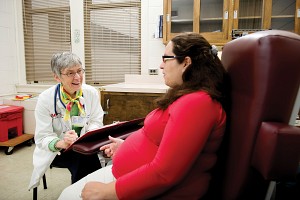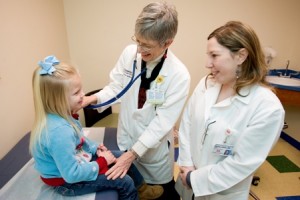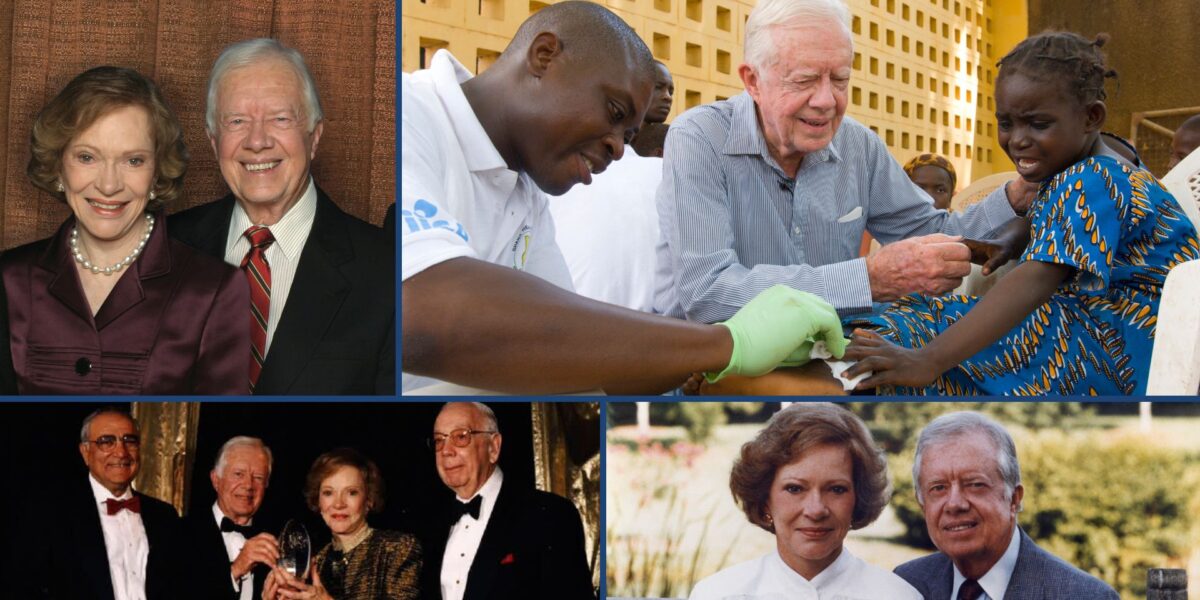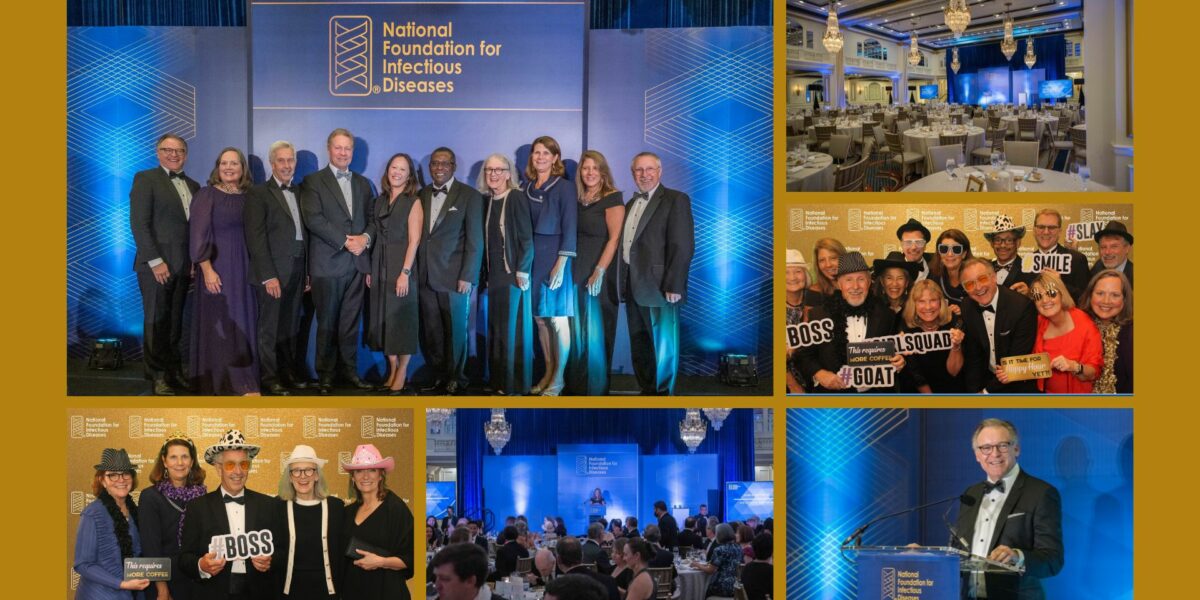
Special thanks to Kathryn M. Edwards, MD, Sarah H. Sell and Cornelius Vanderbilt Chair in Pediatrics and Director, Vanderbilt Vaccine Research Program at Vanderbilt University School of Medicine for sharing her acceptance speech for the 2016 Dr. Charles Mérieux Award for Achievement in Vaccinology and Immunology, delivered by William Schaffner, MD at the 2016 NFID Annual Conference on Vaccine Research.
I am very pleased to be receiving this award today and to join the company of many distinguished vaccinologists who have previously accepted this award. Unfortunately, in spite of being exposed to countless viral infections over my many decades as a pediatrician, I have fallen prey to one of those agents, likely transmitted from my grandchildren, and will not be here today to receive this award in person. However, I cannot think of anyone more appropriate to read this acceptance speech than Dr. Bill [William] Schaffner who has been my esteemed colleague at Vanderbilt for many years. Given his expertise at public speaking and communication, we are all lucky that he is available to deliver this message.
In anticipation of this award, I have tried to distill the many lessons that I have learned into three short stories from my career. The first story began nearly 40 years when I was on call on the last day of my pediatric residency. It was a beautiful spring Sunday morning and I was hoping that my last day as a resident would be a calm and contemplative one. However, at about noon I was called to the Emergency Department to see a toddler with a very high fever and increasing lethargy. It did not take long to diagnose that she had meningitis; I had seen so many cases before. I promptly obtained a lumbar puncture that revealed cloudy spinal fluid. After administering antibiotics, I examined the spinal fluid under the microscope and saw the gram negative coccobacillary organisms of Haemophilus influenza, type b, the most common cause of bacterial meningitis at that time. This was a formidable pathogen and one that I encountered daily since there were always two or three children in the hospital at any one time with Hib disease. As the day progressed the toddler became hemodynamically unstable and no amount of pressors or fluid resuscitation could turn the tide. Through the night progressive shock prevailed. Early in the morning hours she died as her parents watched at her bedside. Their beautiful daughter who had been healthy just the day before had been suddenly taken from them by a devastating bacterial infection.
 This event was a formative one and was likely one of the reasons that, after a clinical and research fellowship in Chicago, I came to Vanderbilt to join the vaccine research team lead by Drs. Peter Wright and Sarah Sell to work on the development of the H. flu vaccine. The new concept of combining the H. flu bacterial polysaccharide to a protein was being tested. Polysaccharide vaccines alone had been poorly immunogenic in the youngest children. We tested the various conjugate Hib vaccines in large studies conducted in Nashville and found them to be safe, immunogenic, and highly effective. Now many decades later, Hib meningitis is nearly gone since are children routinely immunized with this vaccine throughout the world. But disturbingly, now the challenge in the developed world is to maintain confidence in vaccines and make sure that children are vaccinated. As we successfully eliminate many diseases, the public no longer sees the benefits of vaccines. This challenge must be met.
This event was a formative one and was likely one of the reasons that, after a clinical and research fellowship in Chicago, I came to Vanderbilt to join the vaccine research team lead by Drs. Peter Wright and Sarah Sell to work on the development of the H. flu vaccine. The new concept of combining the H. flu bacterial polysaccharide to a protein was being tested. Polysaccharide vaccines alone had been poorly immunogenic in the youngest children. We tested the various conjugate Hib vaccines in large studies conducted in Nashville and found them to be safe, immunogenic, and highly effective. Now many decades later, Hib meningitis is nearly gone since are children routinely immunized with this vaccine throughout the world. But disturbingly, now the challenge in the developed world is to maintain confidence in vaccines and make sure that children are vaccinated. As we successfully eliminate many diseases, the public no longer sees the benefits of vaccines. This challenge must be met.
Lesson Number One: Vaccines are Powerful Agents of Prevention and our children deserve to receive them.
The second story began in the mid-1980s when parents were refusing to give the DPT vaccine because of the severe local and systemic reactions associated with its administration. After a death in Japan temporally associated with pertussis vaccine, the pertussis vaccine in Japan was withdrawn. DPT immunization rates in the United Kingdom were plummeting. Legal action against vaccine manufacturers producing DTP vaccines in the United States had forced many manufacturers to stop making vaccines. A crisis situation was approaching. Fortunately, new, more highly purified pertussis vaccines were being produced and we evaluated them at Vanderbilt. As one of the first sites to study these new acellular vaccines in young children, we compared them to the conventional whole cell vaccines in a double blind manner. The day after vaccination, our study nurses made home visits to check on the infants and predicted with 100% certainty who had received acellular or whole cell vaccine, even though they still remained blinded. The safety profile of the acellular vaccines was remarkable. Working with my colleague Michael Decker, multiple other investigators from other sites, and the National Institutes of Health (NIH), we were able to compare thirteen different acellular vaccines made by many different manufacturers with several whole cell vaccines in one large head to head study conducted at the NIH-funded Vaccine Treatment and Evaluation Units (VTEU). Several thousand children were immunized, followed for safety, and their immune responses were measured. Lessons learned from these acellular pertussis vaccine studies then determined the best products to be introduced into efficacy trials in Sweden and Italy. These large NIH efficacy funded studies clearly demonstrated that the acellular vaccines were efficacious and comparable to the whole cell vaccines. Thus, largely for reasons of safety, the acellular vaccines replaced the whole cell vaccines in much of the developed world. Currently DTP vaccines made with acellular vaccines are some of the best accepted of all vaccines.
 For many years things seemed to be going well with pertussis vaccines and disease was well controlled. However, over the past several years outbreaks have occurred in California and Washington state and pertussis has become the most poorly controlled vaccine-preventable disease in this country. Whether the acellular vaccine primes for a less effective immune response than the whole cell vaccine, whether molecular detection methods are better able to diagnose pertussis than the old culture methods, or whether the vaccines have led to the evolution of new strains will all need to be sorted out. That being said, new solutions are needed.
For many years things seemed to be going well with pertussis vaccines and disease was well controlled. However, over the past several years outbreaks have occurred in California and Washington state and pertussis has become the most poorly controlled vaccine-preventable disease in this country. Whether the acellular vaccine primes for a less effective immune response than the whole cell vaccine, whether molecular detection methods are better able to diagnose pertussis than the old culture methods, or whether the vaccines have led to the evolution of new strains will all need to be sorted out. That being said, new solutions are needed.
Lesson Number Two: Vaccine-Preventable Diseases must continue to be monitored. What seems like a vaccine solution at one time, may need to be modified as times change and organisms evolve. One must always be evaluating the current situation and striving to improve on it.
The last story is one that is being currently written as we try and use the new tools of molecular biology to dissect immune responses and understand adverse events associated with vaccines. Through our NIH funded VTEU, we have recently completed systems biology studies on adjuvanted vaccines to dissect how the adjuvant stimulates the immune system. However, the number of complex interactions observed nearly exceeds the power to conceptualize such interactions and to understand their meaning. The ability to crystalize the antibody structure of a neutralizing epitope and to use this structure to determine the precise antigenic structure needed for a vaccine is amazing. But as we use these new tools, we must also teach the next generation of clinical trialists, molecular biologists, and computational analysts to work together collaboratively to get the most out of the methods. The clinical trialists cannot be relegated to “pokers and bleeders” but must be part of a bigger team that designs the most innovative and informational studies.
Lesson Three: The challenge of new science awaits us all, but it must be harnessed in a collaborative manner so that the best studies can be designed and conducted.
Thank you to NFID for this wonderful award and for allowing me to share my perspectives. I am deeply honored.
To join the conversation, follow NFID on Twitter (@nfidvaccines), like NFID on Facebook, join the NFID Linkedin Group, and subscribe to NFID Updates.
Related Posts

Women Leaders Shaping the Future of Public Health
Trailblazing women leaders share invaluable lessons, urging the next generation of scientists and public health advocates to take risks, stay curious, and make a difference

Remembering Jimmy Carter
The annual Jimmy and Rosalynn Carter Humanitarian Award honors the former president’s lifelong commitment to public service and global health

A Star-Studded Celebration of Public Health Heroes
At the 2024 Awards Gala and Silent Auction, the National Foundation for Infectious Diseases (NFID) recognized the inspiring accomplishments of 3 outstanding public health leaders: Seth F. Berkley, MD; Ighovwerha (Igho) Ofotokun, MD, MSc; and Grace M. Lee, MD, MPH …
